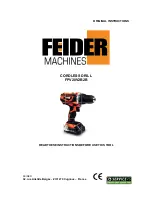
10
OPERATION
SETTING DEPTH
See Figure 6.
The adjustable nosepiece of your tool will automatically
drive screws to preset depths. Make preset depth
adjustments as follows:
■
Unplug your screwdriver.
WARNING:
Failure to unplug your screwdriver could result in
accidental starting causing serious injury.
■
Rotate adjusting sleeve until you obtain the desired
depth for bit holder or screwdriver bit.
■
Test drive a screw in scrap material to determine if it
is correct.
■
Adjust as necessary to increase or decrease the
desired depth.
WARNING:
Always wear safety goggles or safety glasses with
side shields when operating your screwdriver. Failure
to do so could result in dust, shavings, loose particles
or foreign objects being thrown into your eyes,
causing possible serious injury.
DRIVING SCREWS
See Figures 7 and 8.
■
Depress and release the switch trigger to be sure
your screwdriver is in
OFF
position before connecting
it to power supply.
■
Check the direction of rotation lever for correct set-
ting (forward or reverse).
See Figure 4.
■
Secure the workpiece. Use clamps if necessary.
■
Plug your screwdriver into power supply source.
■
Depress the switch trigger to start your screwdriver.
Do not lock the switch
ON
for jobs where your screw-
driver may need to be stopped suddenly.
■
Hold your screwdriver firmly and place the bit and
screw at the point to be driven.
Note:
The bit holder is magnetized and will hold most
commercial drywall screws.
■
Apply quick, snap action type pressure to the
screwdriver bit. The pressure being applied to the
screwdriver bit will engage the clutch and drive the
screw.
See Figures 7 and 8.
You will learn from practice and experience. We suggest
that you begin each new job by driving several test
screws in scrap material to check depth setting.
Fig. 6
Fig. 7
Fig. 8
TO DECREASE DEPTH
OF SCREWDRIVER BIT
TO INCREASE DEPTH
OF SCREWDRIVER BIT
PRESET DEPTH SETTING
OF SCREWDRIVER BIT






























